Botswana is a landlocked country located in Southern Africa in which 70% of its land is the Kgalagadi desert; it is bordered by Namibia, South Africa, Zambia, and Zimbabwe.
Botswana’s vast flatlands are home to around 2.3 million people, with most belonging to the Tswana ethnic group. The San, a minority, are considered the first inhabitants of Southern Africa and still follow a hunter-gatherer lifestyle. In the warm and dry climate, Batswana enjoy a diet rich in meat, starches, grains, and native plants.
As a former British protectorate until 1966, Botswana’s cuisine has been influenced by British tastes while staying true to its roots.
Let’s take a look now at an assortment of foods relished by the Batswana people.
Meat Dishes:
1. Seswaa
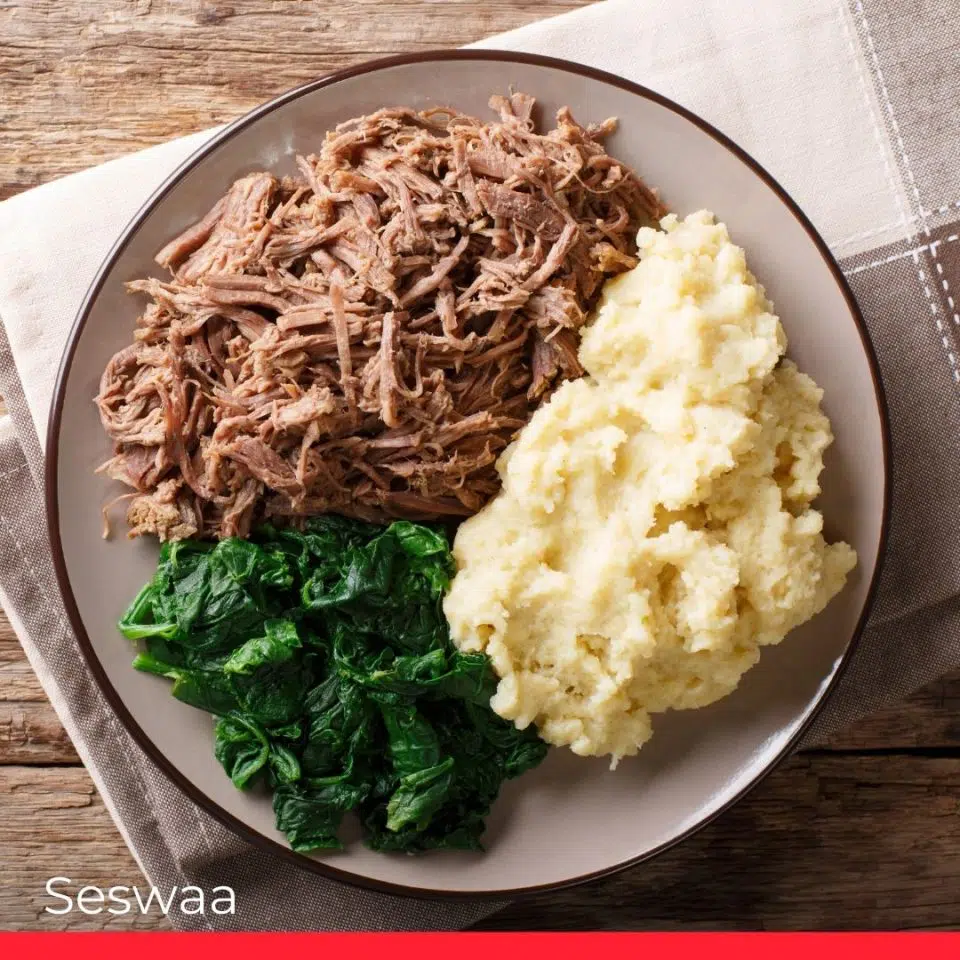
Meat, specifically beef, plays a vital role in Tswana culture; it is present at all types of gatherings and is served in a variety of ways. One popular way that it is served all around the country is Seswaa, which is slow-cooked beef. The most common cuts are the shoulder, rib, rump, and neck. All parts of the cow are used but often cooked separately as they vary in toughness.
Seswaa is traditionally prepared in a three-legged cast iron pot over a sweltering flame; the meat fills most of the pot and is slow-Cooked in water and lots of salt for an average of five hours. In the rural parts of Botswana, Seswaa preparation begins in the morning, cooking throughout the afternoon to be eaten finally at night, with an occasional stir along the way. The result is a comforting stew, with pieces of beef that melt in the mouth.
2. Segwapa

When a cow is slaughtered, its parts are assigned to different types of preparation, consumption, and storage. The making of Segwapa, better known as biltong or beef jerky, is a popular method of preservation and consumption of beef that happens in the winter.
Most Batswana make it in their homes, especially in rural areas where there isn’t any refrigeration to preserve meat. Segwapa is a flavorful meat dish where strips of meat are soaked in vinegar and then coated with a mix of salt and spices like coriander, cloves, and black pepper.
Unlike jerky, Segwapa comes in various forms, from shredded to thick or stick-thin.
3. Mogatla

Mogatla, meaning “oxtail” in Setswana, is a stew that is savored all across Botswana. It could be regarded as a national comfort food because of its deep ties with Botswana’s culture.
Most Batswana get their income from rearing and selling cattle, and they tend to save the less expensive cuts, such as the tail, for special occasions. Oxtail can take longer to cook, as half of its weight is bones and it has tougher meat, but once the juices and flavors of tomatoes, onions, broth, and bay leaves have been absorbed, the result is a delicious stew that is devoured in a matter of moments.
4. Menoto

Menoto is Setswana for “chicken feet”. You can find many Batswana biting down on this gnarly snack during lunch hour as it is a common street food.
They are usually roasted over a barbeque after being seasoned and spiced. Menoto is a popular food that many people prefer to eat hot. It can also be cooked into a stew to bring out its gelatin.
In restaurants, they are served in large portions as chicken feet don’t have much meat on their bones. They are also sold at butcher’s and food stores nationwide.
5. Leleme

Batswana have a very peculiar sense of humor, so much so that they’ve dedicated an entire piece of meat to women: a cow’s tongue referred to as Leleme la Kgomo in Setswana.
In Tswana tradition, cow tongue is prepared like other meats, but there’s a twist – it’s believed that only women should eat it because Tswana women are known for talking a lot!
Although there’s no proof that cow tongue can actually cure talkativeness, Batswana still love the warm and delicate taste of roasted beef tongue.
6. Dibete

Dibete means “livers” in Setswana. Both chicken and beef livers are thoroughly enjoyed and accompany many carbs.
Not only are livers packed with nutrients, but they also make for a great stew which is often devoured with Phaletshe (see 14) or steamed bread.
7. Boerewors
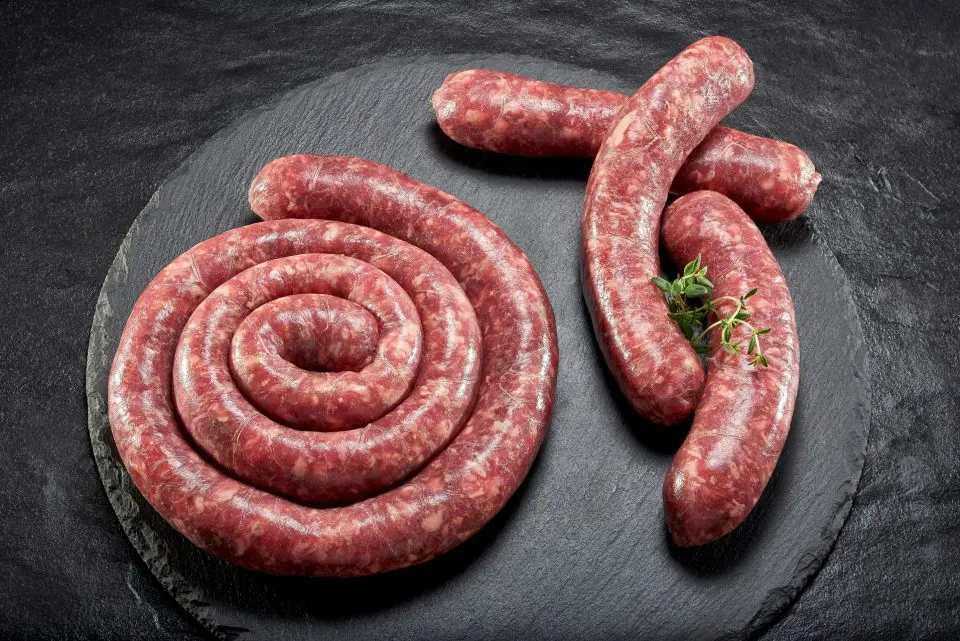
These delicious sausages were invented by Afrikaans and they literally translate to farmer’s sausage. They are incredibly popular in many Southern African countries from South Africa to Namibia and Zimbabwe.
Boerewors are traditionally made with ground pork or beef meat, but sometimes goat or lamb meat is added for extra flavor and consistency. They are a local favorite for braai (barbecue) or stir fry.
8. Ditlhako

Ironically translated to “mean shoes”, Ditlhako is the cooked hooves of cattle. Batswana certainly don’t like wasting food, and enjoy this piece of meat slow-cooked till tender, with most of the gelatin having gone into the soup.
This delicacy thrives because of its added health benefits such as strengthening the joints and aiding skin elasticity.
9. Koko ya Setswana

Unlike its tender-fleshed relative purchased in markets, the Setswana chicken lives an active, free-spirited life, lending it a leathery texture and rubbery chew. An intensive slow cook for two to three hours in boiling water will soften it up nicely.
Only after the slow cooking, is this chicken properly seasoned and served. Since Tswana chickens aren’t sold commercially, they are sold alive and must be slaughtered, plucked, and prepared by hand, taking the word “traditional” to a whole new level.
Baked Dishes:
10. Diphaphatha

When the British arrived on Tswana soil, they introduced a variety of ingredients and baked goods that took on their own local twist and quickly became mainstays of Botswana cuisine.
Diphaphatha are stove-top muffins, similar to English muffins, and are known for their distinctive browning on both sides. Unlike English muffins, Diphaphatha takes less time to prepare and requires fewer ingredients and utensils.
They are traditionally cooked in cast-iron pans over an open flame and are enjoyed with fillings both sweet and savory at any time of the day.
11. Mapakiwa

Another twist on a British treat is Mapakiwa, a hybrid of a scone and a bun with the texture of a brioche roll. Once baked, they are brushed with butter, which gives them an appetizing glaze.
Full-flavored and made from flour, butter, and eggs, Mapakiwa is enjoyed as a teatime dessert, served with a generous helping of jam and more butter! For a twist, you can add raisins or pieces of apple.
12. Matemekwane

Wherever you are in Botswana, there is always someone selling these little parcels of deliciousness.
Matemekwane consists of flavorful dumplings seasoned with herbs and spices, often served with dips and soups. They can also be filled with meat or vegetables, folded, and then fried until golden.
With their remarkable taste and delicate size, it’s no surprise they are a favorite among many!
13. Magwenya

This treat is another crowd-pleaser, for natives and tourists alike. Magwenya are deep-fried donuts sold everywhere in Botswana at all hours of the day.
A phenomenal Magwenya hides its flavor, working equally well as a sweet or a savory snack, always enjoyed with a drink. Magwenya is eaten with anything and everything, ranging from kidneys and livers, all the way to jams and jellies. They can even be stuffed with French fries!
Staple Foods
14. Motogo
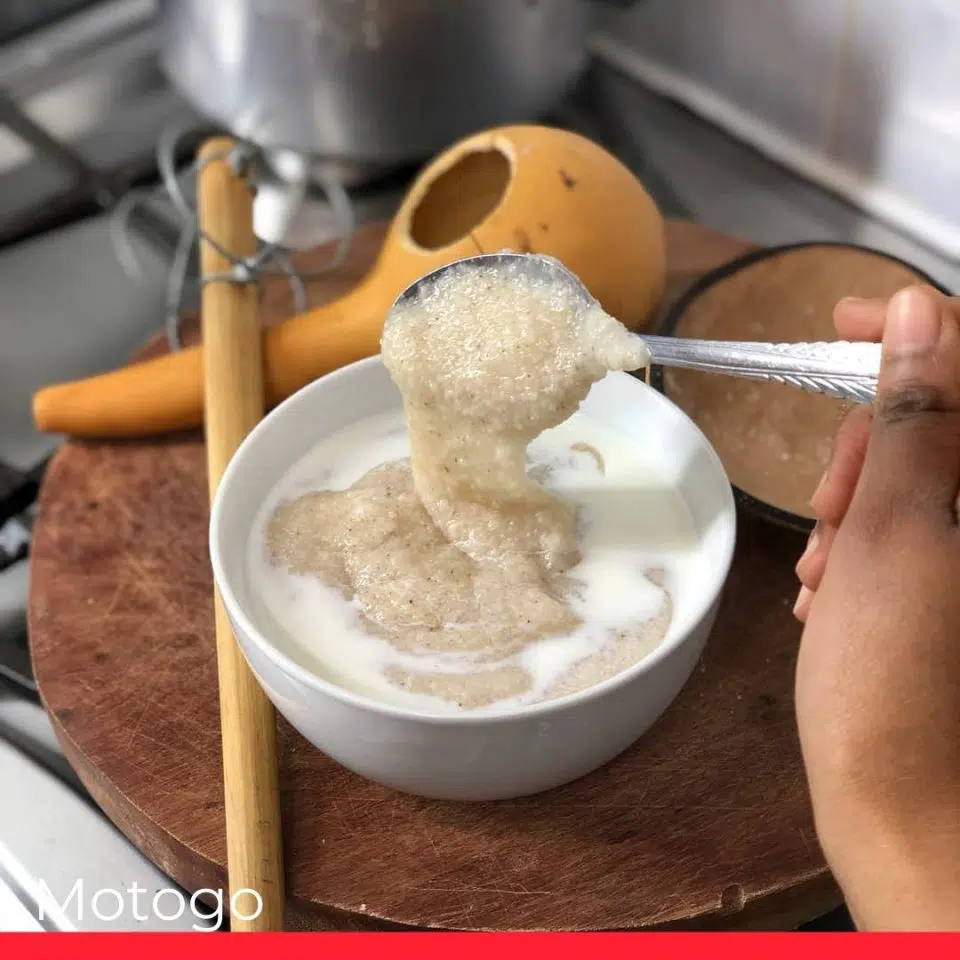
Also known as “slap pap” for its pouring consistency, Motogo is the Setswana name for soft porridge, commonly eaten at breakfast. To make it, a small amount of sorghum and millet powder are stirred steadily with boiling water to avoid lumps until the mixture begins to thicken and bubble.
Instead of using fresh sorghum powder, some people ferment the sorghum in water for weeks to create a bitter substance called tiing. A few tablespoons are taken from the portion of tiing and cooked in boiling water until the mixture thickens and bubbles.
Tiing has a stronger smell than normal Motogo, but many enjoy its bitterness, which can be offset with a few teaspoons of sugar. Motogo is also enjoyed with milk, peanut butter and jam mixed in.
15. Phaletshe

Phaletshe, pronounced “pah-leh-cheh” and also known as pap or papa, is a starch that is fundamental to Southern African cuisine.
Pap meal is made by grinding dry maize into a fine powder, which is then cooked in boiling water with salt added to taste. The prep requires intense mixing in order to avoid lumps. You can tell how strong someone’s arm is by the consistency of their phaletshe!
Batswana can be picky about their pap; some like it smooth with a dash of butter mixed in; giving it a yellow tinge. Some like their phaletshe coarse and moldable in order to use their hands when eating it. This staple of Botswanan cuisinse is commonly served with stew and vegetables.
16. Bogobe
Bogobe is another staple, but unlike phaletshe, is more native to Botswana than any other Southern African nation.
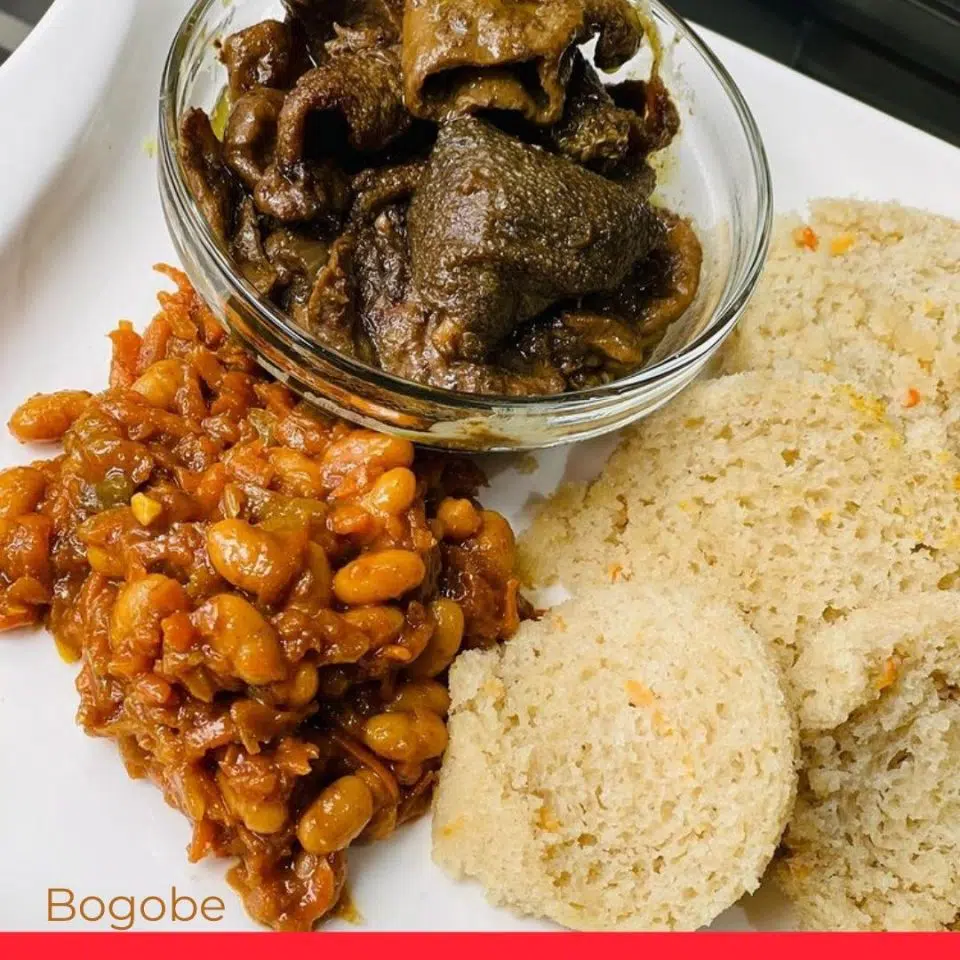
Bogobe is made out of powdered millet or sorghum and cooked in boiling water. Varieties include Bogobe Jwa Lerotse, which is made by incorporating a Lerotse melon into the sorghum mix.
When eaten raw, a Lerotse melon tastes similar to a cucumber, and it gives the Bogobe its famous light-orange skin, which is a crowd-pleaser at weddings. Bogobe Jwa Legala is another variant, cooked in milk for a creamier texture. Both are enjoyed with seswaa and indigenous vegetables.
17. Stampa
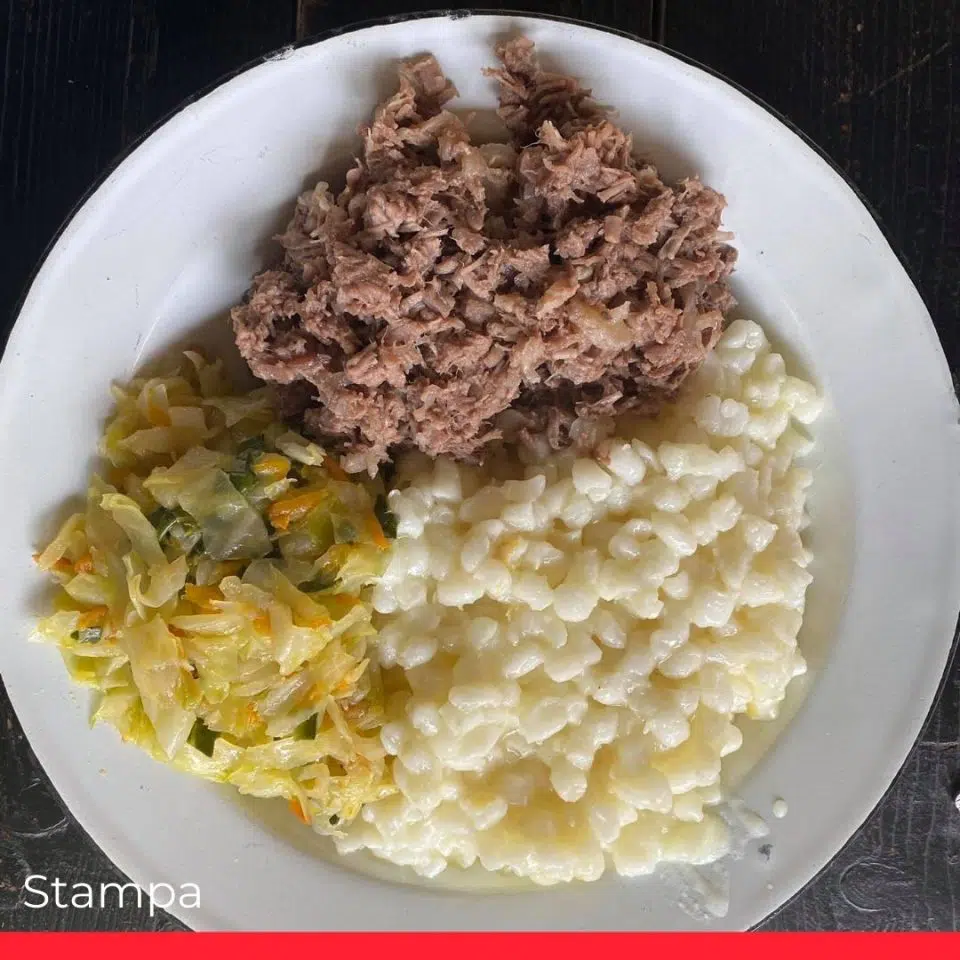
Inspired by the Afrikaans term stampmielies, Stampa consists of dried maize kernels that have been chopped and crushed, but not to the extent of powdering them. The chunks of maize are pressure cooked, sometimes with custard powder for a creamier taste, until they reach a porridge consistency.
Afterward, the Stampa is seasoned with salt, turmeric, and chicken or beef stock. When beans are added, the dish is called Dikgobe. It is one of two starches that are acceptable at funerals, the other being Bogobe.
Vegetables:
18. Morogo

An indigenous vegetable found on many plates is Morogo. Its dark green textured leaves make it easy to identify, and it comes in several varieties that differ in taste.
The most commonly eaten type of Morogo is Morogo Wa Dinawa. It is available in retail stores but can be easily grown in one’s own backyard. Morogo wa Dinawa refers to spinach leaves that are commonly found growing alongside bean plants. These spinach leaves have a subtle taste and are often seasoned with onions and tomatoes for added flavor.
Another notable variety of Morogo is Morogo Wa Thepe. Unavailable in shops and supermarkets, this Morogo grows on the outside of cattle kraals. Should you spot this spinach leaf, you will have hit the motherload! Once harvested, it is dried or cooked immediately. It has a bitter taste that goes down really well with most carbs.
19. Maphutsi

In addition to gem squashes and gourds, Batswana enjoy the occasional Lephutsi as a vegetable accompaniment to dishes. Maphutsi means “squashes” (both butternut and pumpkin), and they are successfully grown and harvested on the parched soil of most rural homesteads.
They are cut into chunks and steamed, then lightly seasoned and served along with a carb and meat. In urbanized parts of the country, Maphutsi is eaten mashed, steamed, or roasted, and flavored with cinnamon, sugar, and butter.
Popular Snacks in Botswana:
20. Madila

Madila is fermented milk and yogurt. It is readily available at celebratory events, and is very popular. Many small businesses in Botswana sell it by the bucketload. And how is it made?
First, cow’s or goat’s milk is left to mature for up to a month. Afterward, most of the whey from the milk is extracted, and the creamy curds are collected. In the past, Madila was made in a Lekuka, which is a leather sack.
21. Kabu le Manoko

Sitting alongside the heavy dishes, Kabu and Manoko are two light snacks enjoyed by natives. Comprising of roasted corn kernels, Kabu is lightly salted so as not to distract from the smokiness of the charred kernels, which dry for two to five days before they are packaged. Manoko is the name of the familiar “8-shaped” peanuts.
They are boiled in salty water until tender, or sometimes in their shells then eaten once cooled. These snacks are grown, prepared, and sold by many spaza shops in townships and villages.
Having come to the end, it is evident that Botswanan cuisine treasures grain and cherishes beef, but also integrates its values, culture, and history, into its food. Tough meats, boundless bread, and filling grains have kept its people satisfied and thriving proving that simplicity is the ultimate sophistication.
Related: Most Popular African Foods & Dishes
The post Top 20 Most Popular Foods in Botswana appeared first on Chef's Pencil.
from Chef's Pencil https://ift.tt/I3tZaPn
via https://chefsspenncil.blogspot.com

No comments:
Post a Comment